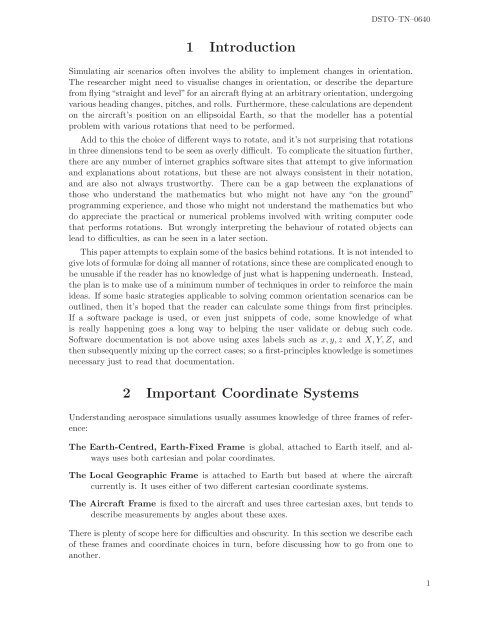Using Rotations to Build Aerospace Coordinate Systems - Defence ...
Using Rotations to Build Aerospace Coordinate Systems - Defence ...
Using Rotations to Build Aerospace Coordinate Systems - Defence ...
Create successful ePaper yourself
Turn your PDF publications into a flip-book with our unique Google optimized e-Paper software.
DSTO–TN–06401 IntroductionSimulating air scenarios often involves the ability <strong>to</strong> implement changes in orientation.The researcher might need <strong>to</strong> visualise changes in orientation, or describe the departurefrom flying“straight and level”for an aircraft flying at an arbitrary orientation, undergoingvarious heading changes, pitches, and rolls. Furthermore, these calculations are dependen<strong>to</strong>n the aircraft’s position on an ellipsoidal Earth, so that the modeller has a potentialproblem with various rotations that need <strong>to</strong> be performed.Add <strong>to</strong> this the choice of different ways <strong>to</strong> rotate, and it’s not surprising that rotationsin three dimensions tend <strong>to</strong> be seen as overly difficult. To complicate the situation further,there are any number of internet graphics software sites that attempt <strong>to</strong> give informationand explanations about rotations, but these are not always consistent in their notation,and are also not always trustworthy. There can be a gap between the explanations ofthose who understand the mathematics but who might not have any “on the ground”programming experience, and those who might not understand the mathematics but whodo appreciate the practical or numerical problems involved with writing computer codethat performs rotations. But wrongly interpreting the behaviour of rotated objects canlead <strong>to</strong> difficulties, as can be seen in a later section.This paper attempts <strong>to</strong> explain some of the basics behind rotations. It is not intended <strong>to</strong>give lots of formulæ for doing all manner of rotations, since these are complicated enough <strong>to</strong>be unusable if the reader has no knowledge of just what is happening underneath. Instead,the plan is <strong>to</strong> make use of a minimum number of techniques in order <strong>to</strong> reinforce the mainideas. If some basic strategies applicable <strong>to</strong> solving common orientation scenarios can beoutlined, then it’s hoped that the reader can calculate some things from first principles.If a software package is used, or even just snippets of code, some knowledge of whatis really happening goes a long way <strong>to</strong> helping the user validate or debug such code.Software documentation is not above using axes labels such as x, y, z and X, Y, Z, andthen subsequently mixing up the correct cases; so a first-principles knowledge is sometimesnecessary just <strong>to</strong> read that documentation.2 Important <strong>Coordinate</strong> <strong>Systems</strong>Understanding aerospace simulations usually assumes knowledge of three frames of reference:The Earth-Centred, Earth-Fixed Frame is global, attached <strong>to</strong> Earth itself, and alwaysuses both cartesian and polar coordinates.The Local Geographic Frame is attached <strong>to</strong> Earth but based at where the aircraftcurrently is. It uses either of two different cartesian coordinate systems.The Aircraft Frame is fixed <strong>to</strong> the aircraft and uses three cartesian axes, but tends <strong>to</strong>describe measurements by angles about these axes.There is plenty of scope here for difficulties and obscurity. In this section we describe eachof these frames and coordinate choices in turn, before discussing how <strong>to</strong> go from one <strong>to</strong>another.1
















